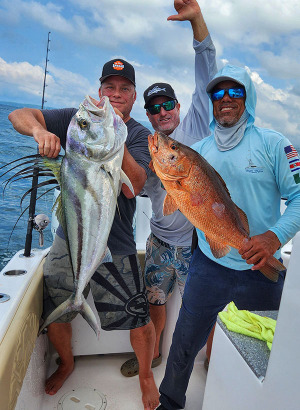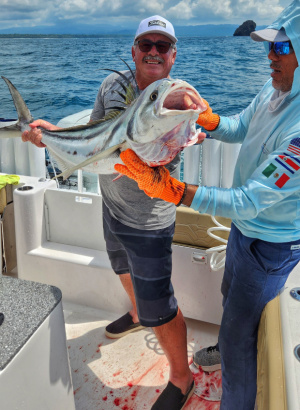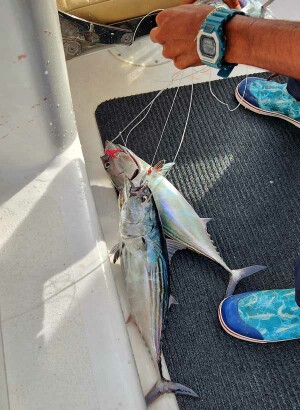Roosterfish, with their distinctive dorsal fins and powerful fights, are prized catches for anglers. This guide compares two premier destinations: Cabo San Lucas and Costa Rica's Osa Peninsula. Discover the best seasons, techniques, and conservation practices for an unforgettable roosterfish adventure in these tropical paradises.
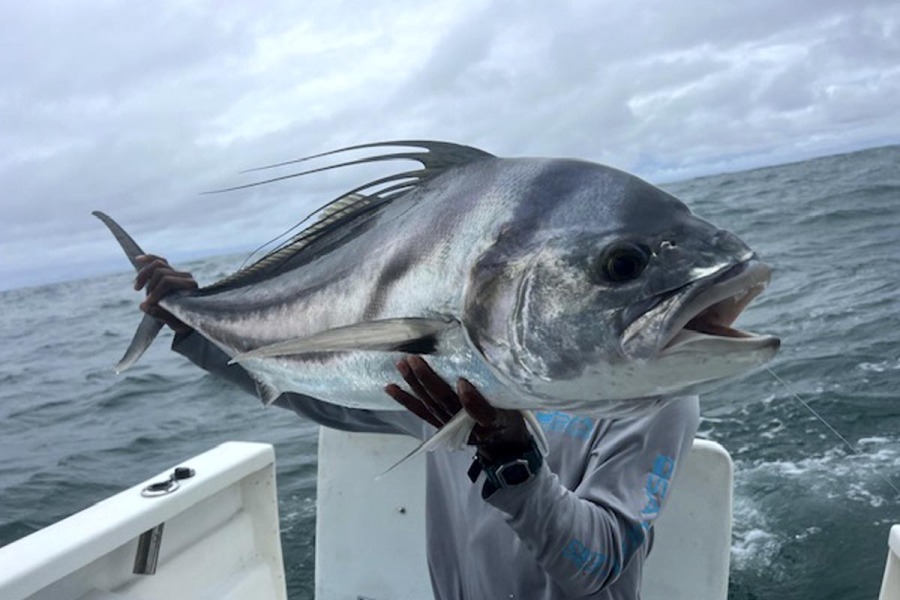
Roosterfish Fishing: Cabo San Lucas vs. Osa Peninsula
Fishing for Roosterfish
- In-depth comparison of two premier roosterfish destinations
- Detailed analysis of why Costa Rica's Osa Peninsula is the top choice for trophy roosterfish
- Extensive coverage of fishing techniques, seasons, and habitat insights
- Comprehensive exploration of wet and dry season impacts on roosterfish behavior
- Expert tips and strategies for targeting trophy-sized roosterfish
While several destinations along the Pacific coast of the Americas offer opportunities to target these magnificent fish, two locations have emerged as the prime hunting grounds for serious roosterfish anglers: Cabo San Lucas, Mexico, and the Osa Peninsula in Costa Rica. Each of these destinations offers its own unique blend of natural beauty, fishing infrastructure, and roosterfish populations, making them the focal points of our comprehensive comparison.
In this extensive guide, we'll delve deep into the world of roosterfish fishing, meticulously comparing these two world-class destinations. We'll explore the reasons behind Costa Rica's rise to prominence, particularly the Osa Peninsula, as the premier location for trophy roosterfish and an unparalleled overall fishing experience. Whether you're a seasoned angler with years of experience chasing roosters or a newcomer eager to test your skills against these formidable adversaries, this article will provide you with valuable insights into the art and science of roosterfish fishing.
We'll cover everything from the unique habitat preferences of roosterfish to the most effective techniques for enticing these often-elusive predators. We'll examine how seasonal changes affect roosterfish behavior and your chances of landing a trophy specimen. You'll learn about the best lures and baits to use, the challenges you might face, and the importance of conservation in ensuring the future of this incredible species.
So, strap in and prepare for an in-depth journey into the exciting world of roosterfish fishing. By the time you finish this guide, you'll be well-equipped with the knowledge to plan your next epic fishing adventure, whether you choose the well-trodden paths of Cabo San Lucas or the wilder shores of Costa Rica's Osa Peninsula.
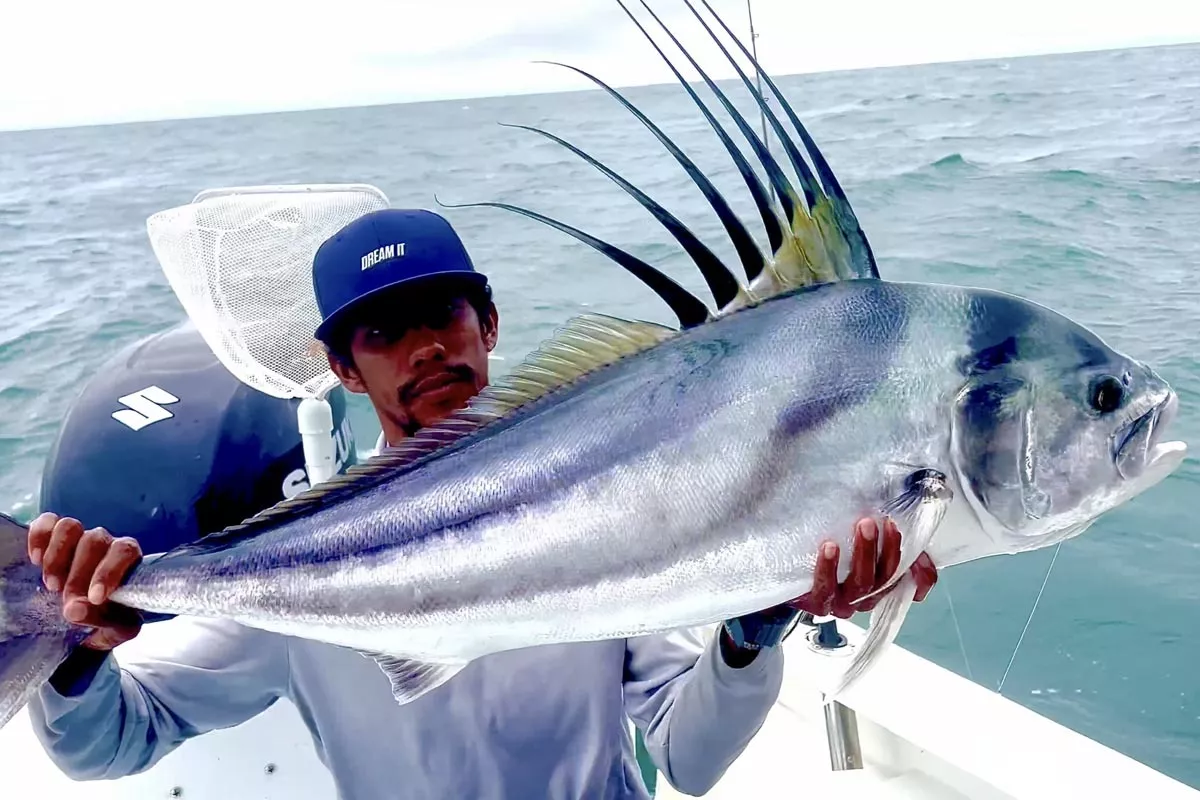
Special thanks to Luis Salazar in Puerto Jimenez, Costa Rica for all his contributions!
Understanding Roosterfish
Adults typically range from 20 to 80 pounds, with some specimens reaching over 100 pounds. Their bodies are deep and laterally compressed, with a silvery-blue coloration adorned with black stripes running vertically down their sides. This striking appearance, combined with their unique dorsal fin, makes them one of the most visually impressive game fish in the world.
Distribution and Habitat
Roosterfish are found in the eastern Pacific Ocean, with a range extending from southern California to Peru. However, they are most abundant in the warmer waters from southern Mexico to Panama. They are primarily an inshore species, typically found within a mile of the coastline and in waters less than 200 feet deep.
Key habitat features for roosterfish include:
- Rocky coastlines: Roosterfish love areas with rocky outcroppings and reefs, which provide ambush points for hunting.
- Sandy beaches: Particularly those adjacent to deeper water or rocky areas.
- River mouths: These areas often concentrate baitfish, attracting roosterfish.
- Offshore islands: The waters around small islands can be roosterfish hotspots.
- Areas with strong currents: Roosterfish often hunt in areas where currents concentrate prey.
Feeding Habits
Roosterfish are opportunistic predators with a diet consisting mainly of various baitfish. Some of their favorite prey include:
- Mullet
- Bonito
- Mackerel
- Sardines
- Herring
- Small jacks
They are known for their aggressive hunting style, often herding baitfish against shorelines or structures before attacking. This behavior can sometimes be observed from the shore, with roosterfish creating surface commotion as they chase their prey.
Life Cycle and Reproduction
While much remains unknown about roosterfish reproduction, we do know that they reach sexual maturity at around 2-3 years of age. Spawning typically occurs offshore, with females releasing millions of eggs that are fertilized externally. The eggs and larvae are pelagic, drifting with ocean currents until the young fish are large enough to swim actively.
Juvenile roosterfish often inhabit shallow, sandy areas close to shore, gradually moving to deeper waters and more complex habitats as they grow. Adults are typically solitary or found in small groups, especially during feeding times.
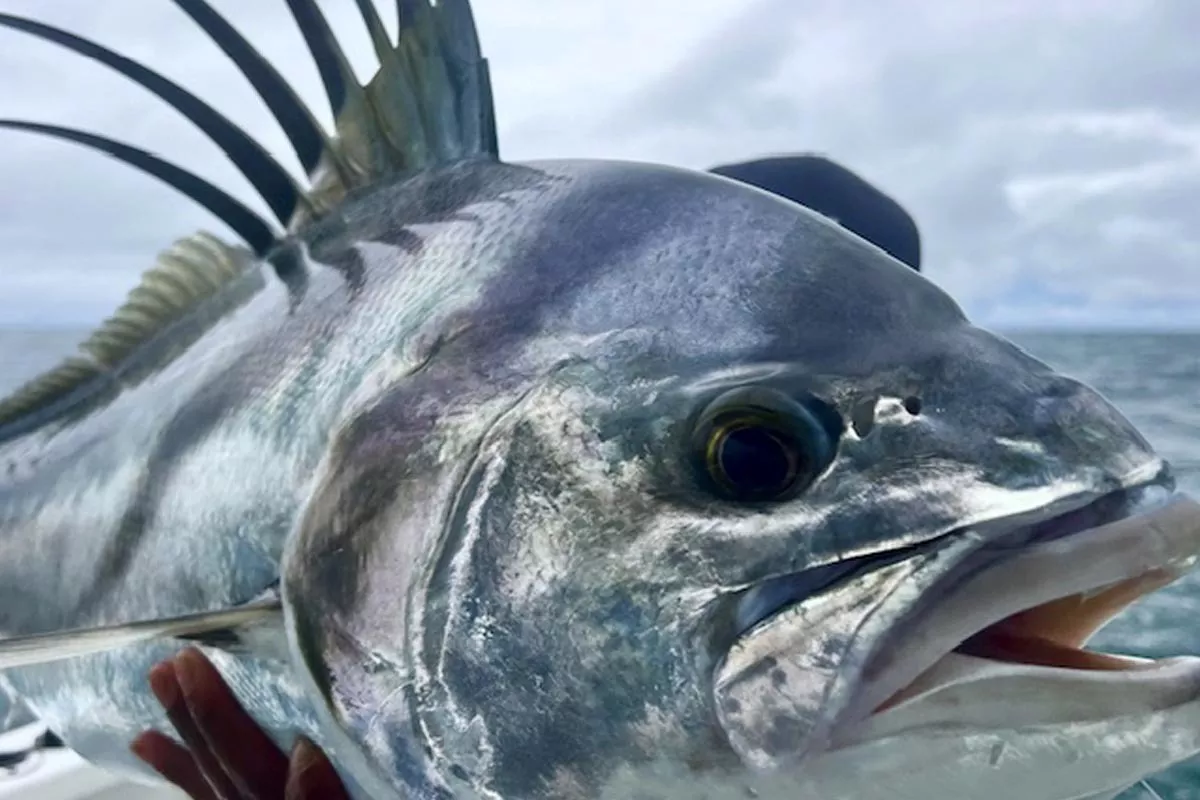
Cabo San Lucas: The Traditional Roosterfish Haven
Cabo San Lucas, situated at the southern tip of Mexico's Baja California Peninsula, has long held a place of honor in the world of roosterfish fishing. This destination, where the Pacific Ocean meets the Sea of Cortez, has been drawing anglers from around the globe for decades, eager to test their skills against the region's famous roosters.
Geography and Climate
Cabo San Lucas boasts a unique geographical location that contributes to its status as a premier fishing destination:
- Confluence of Waters: The meeting of the Pacific Ocean and the Sea of Cortez creates a nutrient-rich environment that supports a diverse marine ecosystem.
- Varied Coastline: The area features a mix of sandy beaches, rocky points, and offshore islands, providing diverse habitats for roosterfish.
- Desert Climate: With over 350 days of sunshine annually, Cabo offers reliable weather for fishing year-round.
Roosterfish Hotspots
Some of the most productive areas for roosterfish in Cabo include:
- Chileno Bay: Known for its rocky points and clear waters, ideal for sight fishing.
- Palmilla Point: A famous spot where roosterfish often chase bait close to shore.
- San Jose del Cabo: The estuary here can be productive, especially during tidal changes.
- East Cape: Slightly further afield, this area is renowned for big roosterfish and less crowded conditions.
Seasonality
While roosterfish can be caught year-round in Cabo, there are some seasonal variations to consider:
- Peak Season: May through July typically sees the highest concentrations of roosterfish.
- Winter Months: December through April can still produce good fishing, though fish may be less concentrated.
- Fall: September through November can be excellent, especially for larger specimens, though weather can be less predictable.
Pros of Fishing in Cabo San Lucas
- Established Reputation: Cabo's long history as a roosterfish destination means tried-and-true fishing spots and techniques.
- Excellent Facilities: Modern marinas, a large charter fleet, and plenty of fishing-focused accommodations.
- Year-round Fishing: The consistent climate allows for fishing opportunities throughout the year.
- Diverse Fishing Grounds: From beach fishing to offshore seamounts, Cabo offers varied roosterfish habitats.
- Accessibility: Direct flights from many US cities make Cabo easily reachable for international anglers.
Cons of Fishing in Cabo San Lucas
- Increasing Fishing Pressure: The popularity of Cabo has led to higher fishing pressure in recent years, potentially impacting fish behavior and size.
- Crowded Peak Season: During prime months, popular fishing spots can become crowded, especially close to town.
- Commercialization: Some anglers feel Cabo has lost some of its "wild" feel due to extensive development.
- Cost: As a popular tourist destination, Cabo can be more expensive than some other roosterfish locations.
Fishing Techniques in Cabo
Cabo San Lucas offers opportunities for various fishing techniques:
- Beach Fishing: Cabo is renowned for its beach fishing opportunities. Anglers often use 4x4 vehicles to cruise the beaches, looking for signs of roosterfish activity.
- Fly Fishing: More prevalent in Cabo than in many other roosterfish destinations. Sight casting to roosters from the beach can be particularly exciting.
- Trolling: Slow trolling with live bait is a staple technique, especially effective around rocky points and islands.
- Casting Lures: Topwater lures and swimbaits can be highly effective, especially early and late in the day.
Local Tip: When beach fishing in Cabo, keep an eye out for frigatebirds diving close to shore. They often indicate the presence of baitfish, which can attract roosterfish.
Cabo San Lucas remains a top destination for roosterfish enthusiasts, offering a blend of reliable fishing, excellent infrastructure, and beautiful surroundings. While it may not be as wild or unpressured as it once was, Cabo still provides anglers with a great chance to tangle with trophy roosterfish in comfortable and accessible surroundings.

The Osa Peninsula: Costa Rica's Roosterfish Paradise
While Cabo San Lucas has long been the go-to destination for roosterfish anglers, the Osa Peninsula in Costa Rica has emerged as a formidable contender in recent years. This remote and biodiverse region offers anglers an opportunity to target trophy-sized roosterfish in a pristine, less-pressured environment that harkens back to the golden age of sportfishing.
Geography and Ecosystem
The Osa Peninsula, located in southwestern Costa Rica, is a true natural wonder:
- Biodiversity Hotspot: Home to Corcovado National Park, often described as "the most biologically intense place on Earth" by National Geographic.
- Pristine Coastline: Miles of undeveloped beaches and rocky shorelines provide ideal roosterfish habitat.
- Nutrient-Rich Waters: The meeting of several ocean currents creates a highly productive marine ecosystem.
- Mangrove Systems: Extensive mangrove forests serve as nurseries for many fish species, including juvenile roosterfish.
Fishing Infrastructure
While not as developed as Cabo San Lucas, the Osa Peninsula offers a more adventurous fishing experience:
- Eco-Lodges: Many accommodations focus on sustainable tourism and provide access to prime fishing areas. Encanta La Vida is a 5 star rated jungle eco-lode on the Osa Peninsula
- Local Guides: Experienced local captains with intimate knowledge of the area's waters and fish behavior. Mike Hennessy and his team with Colio Sportfishing in Golfito are considered to be among the absolute best of the best roosterfish guides in the country.
- Variety of Boats: Options range from traditional pangas to more modern center consoles.
- Limited but Growing Services: While tackle shops are less common, many lodges and guides provide necessary equipment.
Roosterfish Hotspots
- Drake Bay: Known for its rocky coastline and deep waters close to shore.
- Matapalo Point: The peninsula's southernmost point, famous for big roosterfish.
- Golfo Dulce: This deep water gulf provides unique fishing opportunities, especially during certain tides.
- Caño Island: An offshore biological reserve that can hold large numbers of roosterfish.
Seasonality
The Osa Peninsula offers year-round fishing opportunities, but with more pronounced seasonal variations than Cabo:
- Peak Season: December to April (dry season) typically sees the most consistent roosterfish action.
- Off-Season: May to November (rainy season) can provide excellent opportunities for trophy fish, with less fishing pressure.
- Transition Periods: The months at the beginning and end of the rainy season can be particularly productive.
Pros of Fishing in the Osa Peninsula
- Trophy Fish Potential: The area consistently produces world-record-sized roosterfish.
- Less Fishing Pressure: Compared to Cabo, the Osa Peninsula sees fewer anglers, potentially leading to larger and less wary fish.
- Pristine Environment: The undeveloped nature of the peninsula provides a truly wild fishing experience.
- Diverse Fishery: In addition to roosterfish, anglers can target a wide variety of other species.
- Eco-Tourism Focus: Many operators emphasize sustainable practices, helping to preserve the quality of the fishery.
Cons of Fishing in the Osa Peninsula
- Less Developed Infrastructure: While improving, the area has fewer amenities compared to more established destinations.
- Accessibility: Reaching the Osa Peninsula typically requires more travel time and connections.
- Seasonal Considerations: The rainy season can bring challenging weather conditions.
- Limited Luxury Options: High-end accommodations and services are less common than in Cabo.

Fishing Techniques in the Osa Peninsula
The Osa Peninsula offers opportunities for various fishing techniques, with some differences from Cabo:
- Live Bait Fishing: The use of large live baits like bonito, mullet, or blue runners is particularly effective in the Osa Peninsula. Slow trolling these baits around rocky points and offshore islands is a proven technique for trophy roosterfish.
- Popping: Casting large surface poppers is an exciting and effective method, especially during low light conditions. The commotion created by these lures can trigger aggressive strikes from roosterfish.
- Jigging: Vertical jigging with heavy metal jigs can be productive, especially when roosterfish are holding in deeper water around underwater structures.
- Fly Fishing: While challenging, fly fishing for roosterfish is possible in the Osa Peninsula. Sight casting to cruising fish from a boat or the beach can provide an unforgettable experience.
- Inshore Trolling: Slow trolling along the coastline, especially near river mouths and rocky points, can be highly effective.
Local Tip: In the Osa Peninsula, pay attention to bird activity, particularly frigatebirds and pelicans. They often indicate the presence of baitfish schools, which can attract roosterfish.
The Osa Peninsula offers a more "wild" roosterfish experience compared to Cabo San Lucas. While it may require more effort to reach and fish effectively, many anglers find the potential for trophy fish and the unspoiled environment well worth the extra effort.

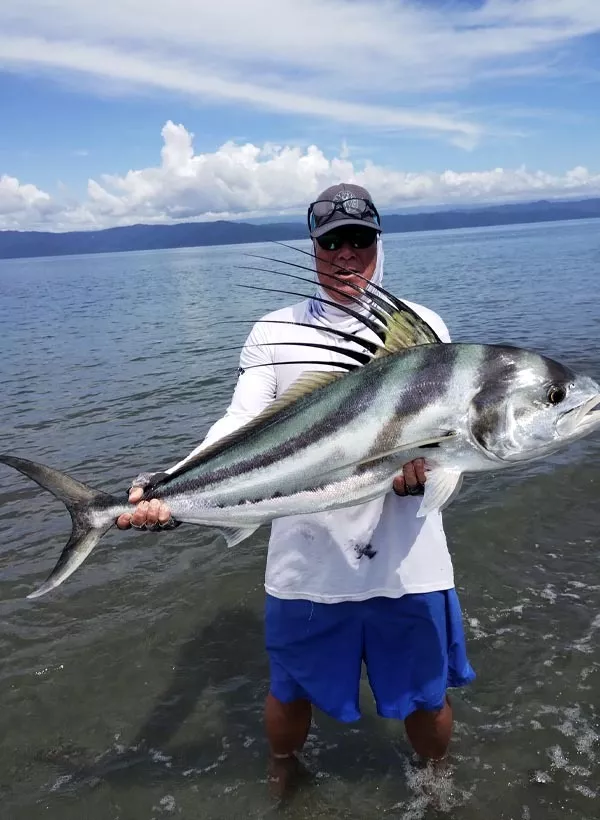
Why Costa Rica is the Premier Roosterfish Destination
While both Cabo San Lucas and the Osa Peninsula offer excellent roosterfish fishing, Costa Rica, particularly the Osa Peninsula, has emerged as the top choice for serious anglers seeking trophy roosterfish. Here's an in-depth look at why:
1. Spectacular Fishery
Costa Rica's Pacific coast, especially the Osa Peninsula, boasts an incredibly diverse and healthy fishery:
- Nutrient-Rich Waters: The convergence of ocean currents creates a nutrient-rich environment that supports a robust food chain.
- Variety of Game Fish: In addition to roosterfish, anglers can target dorado (mahi-mahi), yellowfin tuna, cubera snapper, and various billfish species.
- Year-Round Opportunities: The consistent climate allows for productive fishing throughout the year, with different species peaking at various times.
This diversity ensures that even if roosterfish aren't biting, there's always exciting fishing to be had, enhancing the overall angling experience.
2. Pristine Environment
Costa Rica's commitment to environmental conservation has helped maintain the health of its marine ecosystems:
- Protected Areas: The country has designated over 25% of its land as protected areas, including marine reserves that benefit fish populations.
- Corcovado National Park: This UNESCO World Heritage site on the Osa Peninsula is one of the most biodiverse places on Earth, contributing to the overall health of the surrounding marine ecosystem.
- Limited Development: Unlike more developed destinations, much of Costa Rica's coastline remains relatively untouched, preserving critical fish habitats.
3. Less Fishing Pressure
The remote nature of many Costa Rican fishing spots, particularly on the Osa Peninsula, has helped preserve the quality of the fishery:
- Fewer Anglers: Compared to popular destinations like Cabo San Lucas, Costa Rica sees fewer sport fishermen, especially in more remote areas.
- Larger Fish: Less fishing pressure often translates to more and bigger fish, including trophy-sized roosterfish.
- Natural Behavior: Fish in less pressured areas may exhibit more natural behavior, potentially making them easier to catch for skilled anglers.
4. Eco-Tourism Focus
Costa Rica's emphasis on sustainable tourism practices helps ensure the long-term health of its fisheries:
- Catch and Release: Many lodges and guides promote catch-and-release practices, especially for roosterfish.
- Sustainable Fishing Methods: There's a growing emphasis on using circle hooks and other techniques that minimize harm to fish.
- Education: Many operators incorporate conservation education into their programs, helping to create more environmentally conscious anglers.
5. Adventure Factor
Fishing in Costa Rica, especially on the Osa Peninsula, offers a sense of adventure and exploration that's harder to find in more developed destinations:
- Untouched Coastlines: Miles of undeveloped beaches and rocky shorelines provide a backdrop that enhances the overall fishing experience.
- Wildlife Encounters: It's not uncommon to see exotic wildlife while fishing, from scarlet macaws flying overhead to humpback whales breaching in the distance.
- Off-the-Beaten-Path Experience: Many fishing spots in Costa Rica feel like genuine discoveries, offering a sense of pioneering adventure.
6. Consistent Weather
While Costa Rica does have distinct dry and rainy seasons, the weather is generally favorable for fishing year-round:
- Stable Temperatures: The tropical climate means warm temperatures throughout the year, with less extreme seasonal variations than some other destinations.
- Predictable Patterns: Even during the rainy season, weather patterns are often predictable, with mornings typically clear and rain more likely in the afternoons.
7. Value for Money
While not necessarily cheaper than other destinations, Costa Rica often offers better value for the fishing experience:
- Less Crowded: Your fishing dollar often buys a more exclusive experience, with less competition for prime fishing spots.
- Diverse Opportunities: The variety of fishing opportunities available often means more bang for your buck in terms of the overall experience.
8. Strong Conservation Ethic
Costa Rica has been a leader in conservation efforts, which directly benefits its fisheries:
- Marine Protected Areas: The country has established numerous marine protected areas, which serve as nurseries and safe havens for fish populations.
- Sustainable Fishing Regulations: Costa Rica has implemented various regulations to protect its marine resources, including restrictions on commercial fishing in certain areas.
9. World Record Potential
Costa Rica, particularly the Osa Peninsula, has produced numerous record-breaking roosterfish:
- IGFA Records: Many International Game Fish Association (IGFA) world records for roosterfish have come from Costa Rican waters.
- Trophy Potential: The combination of a healthy ecosystem, less fishing pressure, and good genetics means Costa Rica consistently produces trophy-sized roosterfish.
In summary, while both Cabo San Lucas and Costa Rica offer excellent roosterfish fishing, Costa Rica's combination of a healthy, diverse fishery, pristine environment, less fishing pressure, and focus on sustainability gives it the edge as the premier destination for anglers seeking the ultimate roosterfish experience. The Osa Peninsula, in particular, represents a last frontier of sorts for roosterfish enthusiasts, offering the chance to target these magnificent fish in a truly wild and unspoiled setting.
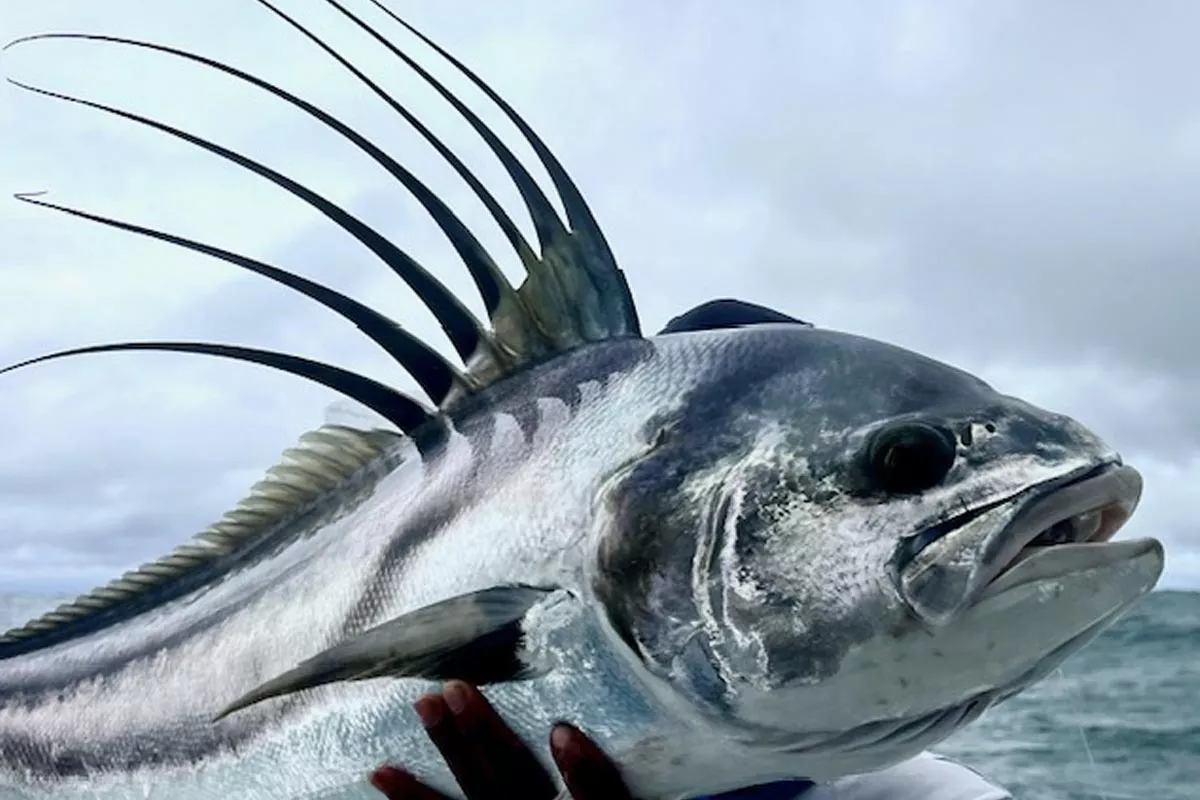
Roosterfish Habitat and Behavior
Understanding roosterfish habitat preferences and behavior is crucial for successful fishing. These powerful predators have specific environmental preferences and exhibit fascinating behavioral patterns that anglers can leverage to increase their chances of a successful catch.
Preferred Habitat
Roosterfish are primarily found in nearshore waters, typically within a mile of the coastline. They show a strong preference for certain types of environments:
- Rocky coastlines and reefs: Roosterfish favor areas with rocky shores and reefs, which provide ideal ambush points for hunting prey. These structures create current breaks and eddies where roosterfish can conserve energy while waiting for prey.
- Sandy drop-offs: Areas where sandy bottoms quickly drop into deeper water are preferred habitats. Drop-offs create transition zones that roosterfish exploit for feeding.
- Submerged structures: Underwater features like shipwrecks, submerged rocks, and artificial reefs are prime roosterfish habitats. Hard bottom structures offer hiding spots and attract prey species.
- Points and headlands: Coastal points and headlands, especially those with strong currents, are favored by roosterfish. These areas often concentrate baitfish, making them prime hunting grounds.
- River mouths: When bait is present, roosterfish can be found near river mouths. However, they typically avoid brackish water, preferring the cleaner, more oxygenated water just outside the river mouth.
- Surf zones: Roosterfish are known to hunt in turbulent surf zones, especially when pushing baitfish against the shore. This behavior can sometimes be observed from the beach, making them a target for surf anglers.
Depth Preferences
Roosterfish exhibit interesting depth preferences that can vary based on factors like time of day, season, and availability of prey:
- Shallow Water: They often hunt in very shallow water, sometimes as little as 3-6 feet deep, especially early and late in the day.
- Mid-Range Depths: Roosterfish spend over 90% of their time between the surface and 12 meters (about 40 feet) depth.
- Deeper Dives: While less common, roosterfish have been known to dive to depths of 30-50 meters (100-165 feet), especially when following prey or seeking cooler water.
Behavior Patterns
- Feeding Strategy: Roosterfish are ambush predators, often using submerged rocks or structures as hiding spots. They'll wait for baitfish to pass by, then burst out with incredible speed to catch their prey.
- Schooling Behavior: While often solitary, roosterfish can be found in small groups, especially when feeding. Juvenile roosterfish are more likely to school than adults.
- Tidal Influence: Roosterfish behavior is highly tidal-dependent. They often become more active during tidal changes, using the water movement to their advantage when hunting.
- Time of Day: Roosterfish are generally more active during low light conditions - early morning and late afternoon. However, they can feed throughout the day if conditions are right.
- Seasonal Movements: During the wet season, roosterfish may scatter to deeper waters in search of prey. In the dry season, they're more likely to be found in shallower coastal regions.
- Hunting Techniques: Roosterfish often herd baitfish against structures or the shore before attacking. They may use their distinctive dorsal fin to corral or disorient prey.
- Response to Pressure: In areas with heavy fishing pressure, roosterfish can become more wary and harder to catch. They may change their feeding patterns or move to less pressured areas.
Environmental Factors
Several environmental factors can influence roosterfish behavior and location:
- Water Temperature: Roosterfish prefer warm water, typically between 70°F to 85°F (21°C to 29°C). Larger specimens seem to tolerate slightly cooler water better than smaller ones.
- Water Clarity: While roosterfish can be caught in various water conditions, they generally prefer clear to slightly off-color water. They rely heavily on sight when hunting, so extremely turbid water can negatively impact their feeding.
- Currents: Areas with moderate current often hold roosterfish, as these zones concentrate baitfish. Strong currents around points or islands can be particularly productive.
- Bait Presence: The presence of baitfish is the single most important factor in locating roosterfish. Areas with consistent bait populations will hold roosterfish more reliably.
Understanding these habitat preferences and behavioral patterns is key to successfully targeting roosterfish. By focusing on the right areas at the right times and under the right conditions, anglers can significantly increase their chances of encountering these magnificent game fish.
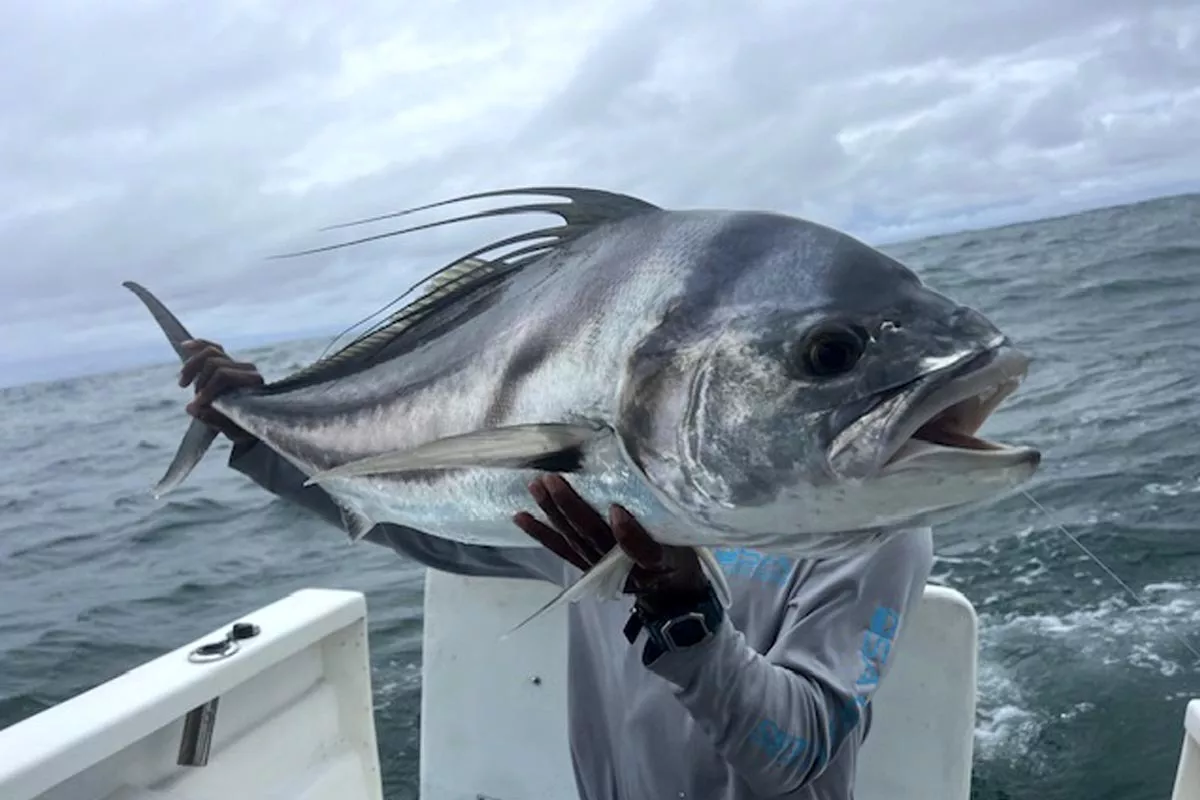
Seasonal Considerations: Wet Season vs. Dry Season
The wet and dry seasons play a significant role in roosterfish behavior and fishing success in both Cabo San Lucas and the Osa Peninsula. Understanding these seasonal patterns can help anglers plan their trips and adjust their tactics for the best chance of success.
Wet Season (May to November)
The wet season, also known as the "green season" in Costa Rica, brings more rainfall and can significantly impact roosterfish fishing. Here's what anglers need to know:
Characteristics:
- Higher rainfall, particularly in the afternoons
- Increased river outflows
- Potentially rougher sea conditions (This is relative, because rough seas in Costa Rica are still very mild for most places in the world)
- Warmer water temperatures
Impacts on Roosterfish
- Fish Distribution: Roosterfish may scatter to deeper waters in search of prey. The influx of freshwater from rivers can push baitfish (and consequently roosterfish) further offshore.
- Feeding Patterns: The abundance of green jacks, a primary food source for larger roosterfish, increases during this time. This can lead to more active feeding by trophy-sized roosterfish.
- Water Conditions: Increased rainfall can lead to reduced visibility in nearshore waters. Roosterfish may move to areas with clearer water or adjust their feeding strategies.
Fishing Considerations
- Trophy Opportunities: The wet season, especially August through November, is often considered the best time for catching trophy-sized roosterfish on the Osa Peninsula. Less fishing pressure during this "off-season" can lead to less wary fish.
- Technique Adjustments: Anglers may need to fish deeper or further offshore compared to the dry season. Live bait fishing becomes even more effective, as it doesn't rely on water clarity.
- Weather Challenges: Be prepared for sudden rain showers and potentially rougher sea conditions. Morning fishing trips are often more productive and comfortable.
- Habitat Focus: Concentrate on areas where freshwater meets saltwater, as these zones can concentrate baitfish. Offshore structures may hold more fish during this season.
Pro Tip: During the wet season, pay close attention to river mouths after heavy rains. The influx of nutrients can attract baitfish and predators, including large roosterfish.
Dry Season (December to April)
The dry season brings more stable weather conditions and is traditionally the peak tourist season in both Cabo San Lucas and Costa Rica. Here's what it means for roosterfish fishing:
Characteristics:
- Less rainfall and more consistent weather
- Calmer sea conditions
- Cooler water temperatures
- Higher fishing pressure due to peak tourist season
Impacts on Roosterfish
- Fish Distribution: Roosterfish are more likely to be found in shallower coastal regions. They may be more evenly distributed along the coastline.
- Feeding Patterns: Juvenile roosterfish are more active during this time, as they prefer to hunt balls of anchovies which are more abundant. Adult roosterfish may focus more on nearshore bait species.
- Water Conditions: Improved visibility can make sight fishing more productive. Cooler water temperatures may concentrate fish in certain areas.
Fishing Considerations
- Technique Opportunities: The dry season is excellent for sight fishing and fly fishing due to better visibility. Topwater lures can be highly effective, especially early and late in the day.
- Increased Pressure: Popular fishing spots may be more crowded, especially in well-known destinations like Cabo San Lucas. Fish may be more wary due to increased angling pressure.
- Consistent Conditions: More stable weather makes it easier to plan multi-day fishing trips. Calmer seas can allow for more comfortable fishing, especially for those prone to seasickness.
- Habitat Focus: Pay attention to rocky points, reefs, and other structures where roosterfish may be actively hunting. Early morning and late afternoon fishing can be particularly productive.
Local Insight: In Cabo San Lucas, the period from May to July is often considered the peak season for roosterfish, bridging the dry and wet seasons. This time combines good weather conditions with the beginning of baitfish migrations.
Transition Periods
The transition periods between seasons (April-May and November-December) can offer unique opportunities:
- Changing conditions can trigger increased feeding activity.
- Fish behavior may be less predictable, but potentially more active.
- Fewer tourists can mean less fishing pressure.
Conclusion on Seasonality
While roosterfish can be caught year-round in both Cabo San Lucas and the Osa Peninsula, understanding seasonal patterns can greatly improve your chances of success. The wet season often provides better opportunities for trophy fish, especially in Costa Rica, but comes with weather-related challenges. The dry season offers more consistent conditions and can be excellent for a variety of fishing techniques, but may see increased fishing pressure, particularly in popular spots.
Ultimately, the "best" time to fish for roosterfish depends on your specific goals, preferred fishing methods, and tolerance for various weather conditions. By understanding these seasonal patterns, anglers can make informed decisions about when to plan their trips and what techniques to employ once they're on the water.
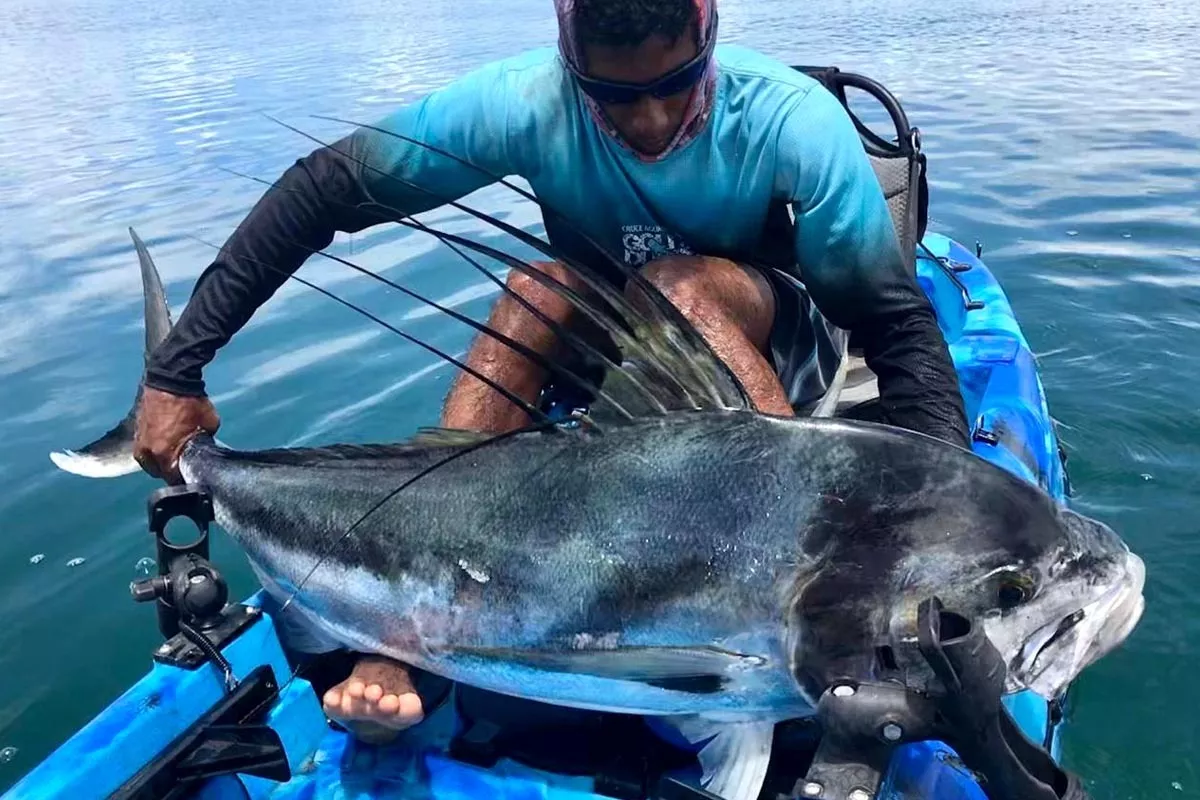
Techniques for Targeting Trophy Roosterfish
Catching a trophy roosterfish is a goal for many anglers, and it requires a combination of skill, knowledge, and sometimes a bit of luck. Here are some proven techniques to increase your chances of landing that fish of a lifetime:
1. Live Bait Fishing
Live bait fishing is often considered the most effective method for targeting trophy roosterfish. These predators are attracted to the natural movement and scent of live bait, making it an irresistible offering.
Key Points:
- Bait Selection: Use large baits like bonito, mullet, or blue runners. Trophy roosterfish often prefer larger prey.
- Rigging: Use a bridle rig or a circle hook through the nose to keep the bait lively.
- Presentation: Slow troll live baits around rocky structures and drop-offs, or free-line them in areas where roosterfish are spotted.
Pro Tip: When using live bait, pay attention to the bait's behavior. If it suddenly becomes agitated, it may indicate the presence of a predator nearby.
2. Topwater Lures
Using topwater lures can be one of the most exciting ways to catch roosterfish. The visual thrill of seeing a large rooster attack a surface lure is hard to beat.
Key Points:
- Lure Selection: Large poppers or stick baits in the 6-9 inch range are effective.
- Retrieval: Use an aggressive, erratic retrieve to mimic a fleeing baitfish.
- Timing: Early morning and late afternoon are often the best times for topwater action.
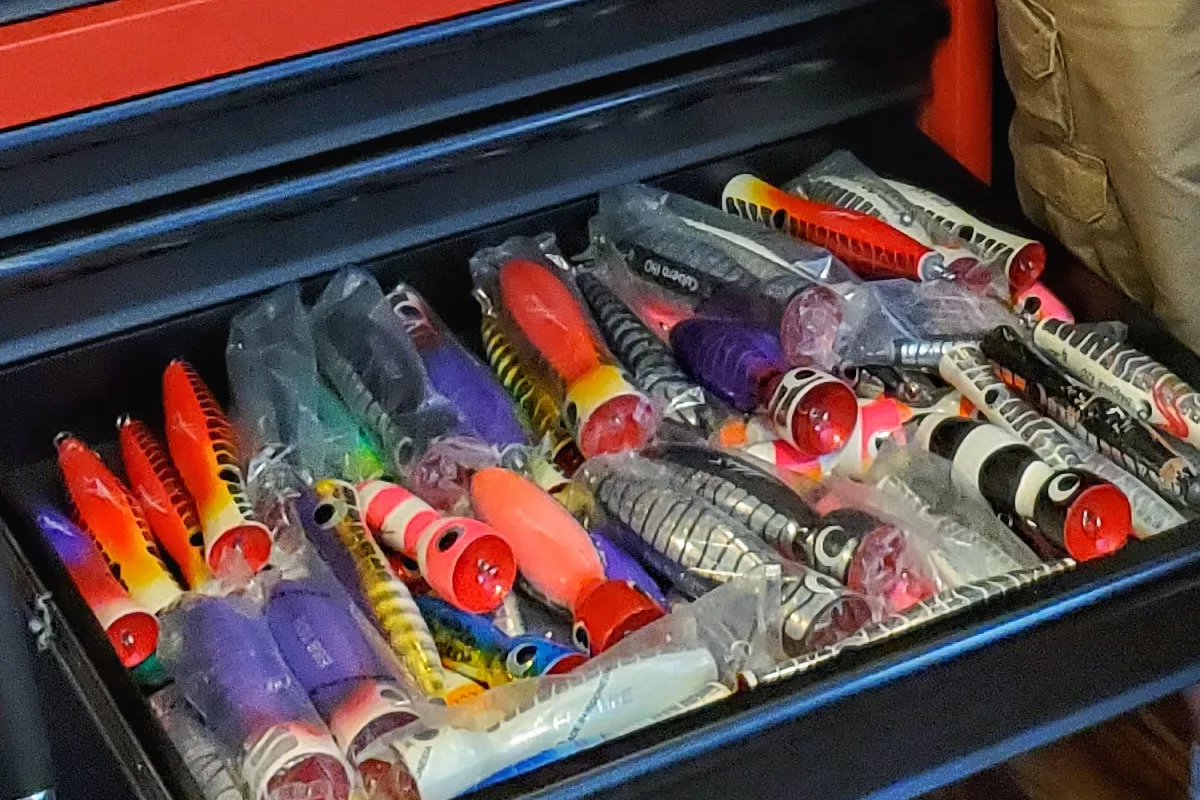
3. Vertical Jigging
Vertical jigging can be highly effective when roosterfish are holding in deeper water around structures.
Key Points:
- Jig Selection: Use heavy jigs in the 7-12 ounce range.
- Technique: Drop the jig to the bottom, then use sharp, upward jerks followed by a controlled fall.
- Location: Focus on underwater pinnacles, drop-offs, and other structures that hold bait.

4. Sight Fishing
Sight fishing for roosterfish, either from a boat or the shore, can be challenging but incredibly rewarding.
Key Points:
- Spotting: Look for the distinctive dorsal fin of roosterfish breaking the surface.
- Approach: Position yourself ahead of the fish's path and cast well in front of them.
- Lure Choice: Use lures that can be cast long distances, like stick baits or poppers.
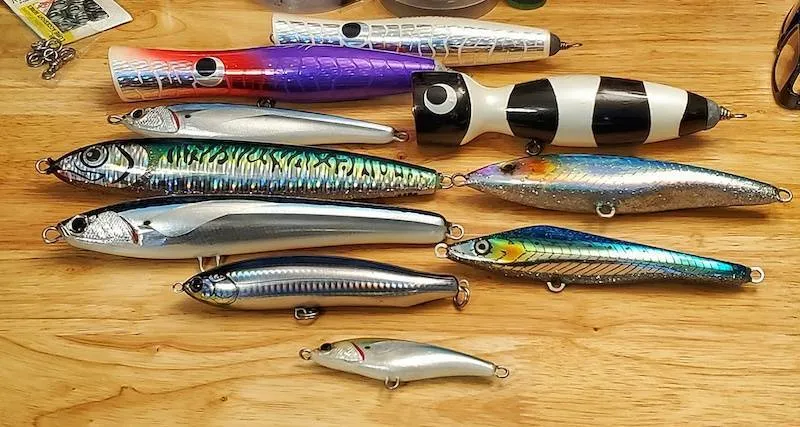
5. Trolling
While not as exciting as some other methods, trolling can be an effective way to cover water and locate roosterfish.
Key Points:
- Speed: Troll slowly, around 2-4 knots.
- Lure Selection: Use large swimming plugs or skirted trolling lures.
- Location: Focus on areas just outside the surf line and around rocky points.
6. Fly Fishing
Fly fishing for roosterfish is challenging but can be incredibly rewarding for skilled anglers.
Key Points:
- Gear: Use 10-12 weight rods with sturdy reels and plenty of backing.
- Flies: Large streamers or poppers in the 4-6 inch range can be effective.
- Technique: Be prepared to make long, accurate casts and strip the fly quickly.
Advanced Tactics for Trophy Roosterfish
- Kite Fishing: In some areas, kite fishing has proven effective for presenting baits to wary roosterfish without spooking them with boat noise.
- Downrigger Fishing: Using downriggers to present live baits at specific depths can be effective when roosterfish are holding deeper.
- Teasing: Some captains use hookless teasers to bring roosterfish closer to the boat before presenting a hooked bait or lure.
- Night Fishing: While less common, fishing for roosterfish at night can produce trophy specimens, especially around well-lit areas that attract baitfish.
Factors to Consider When Targeting Trophy Roosterfish
- Location: Focus on areas known to hold larger fish. In many cases, bigger roosterfish prefer slightly deeper water adjacent to structure.
- Timing: Understanding seasonal patterns and daily feeding cycles can greatly increase your chances of encountering trophy fish.
- Patience: Trophy fishing often involves fewer bites but higher quality fish. Be prepared for long periods between strikes.
- Gear: Ensure your equipment is up to the task. Trophy roosterfish can put a serious strain on tackle.
- Conservation: Consider practicing catch and release, especially for large, breeding-sized fish to help maintain healthy populations.
Remember, landing a trophy roosterfish is as much about preparation and persistence as it is about luck. By employing these techniques and considering these factors, you'll greatly increase your chances of hooking into the roosterfish of a lifetime.
Best Lures and Baits for Roosterfish
Choosing the right lures and baits is crucial for successful roosterfish fishing. While live bait is often considered the most effective, artificial lures can also be highly productive. Here's a comprehensive look at the best options:
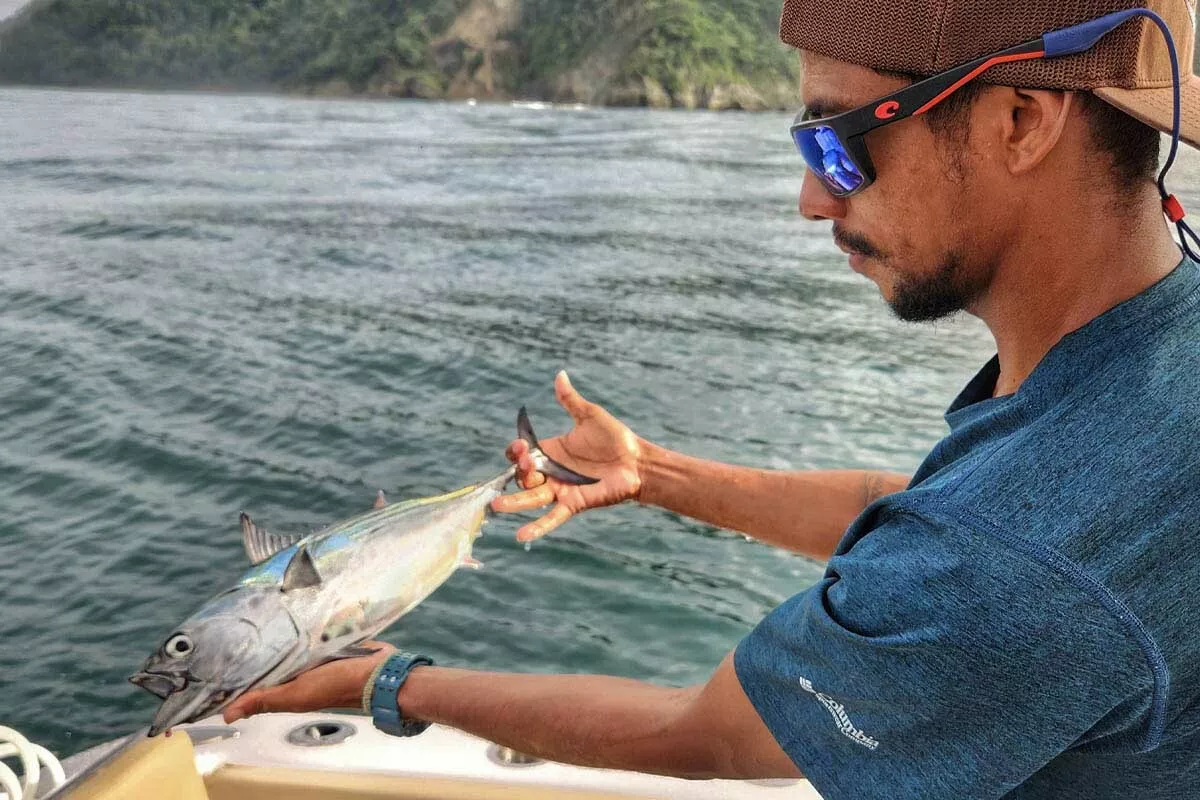
Live Baits
Live bait is generally the top choice for targeting roosterfish, especially trophy-sized specimens.
- Bonito:
- Why it works: Large profile, strong swimming action
- Best for: Trophy roosterfish over 50 pounds
- Mullet:
- Why it works: Natural prey item, erratic swimming motion
- Best for: All sizes of roosterfish
- Blue Runners (Hardtails):
- Why it works: Hardy, long-lasting on the hook
- Best for: General roosterfish fishing
- Lookdowns (Moonfish):
- Why it works: Flashing sides attract attention
- Best for: Clear water conditions
- Sardines:
- Why it works: Abundant natural prey
- Best for: Smaller to medium roosterfish
Pro Tip: When using live bait, try to match the predominant baitfish in the area. Local knowledge can be invaluable here.
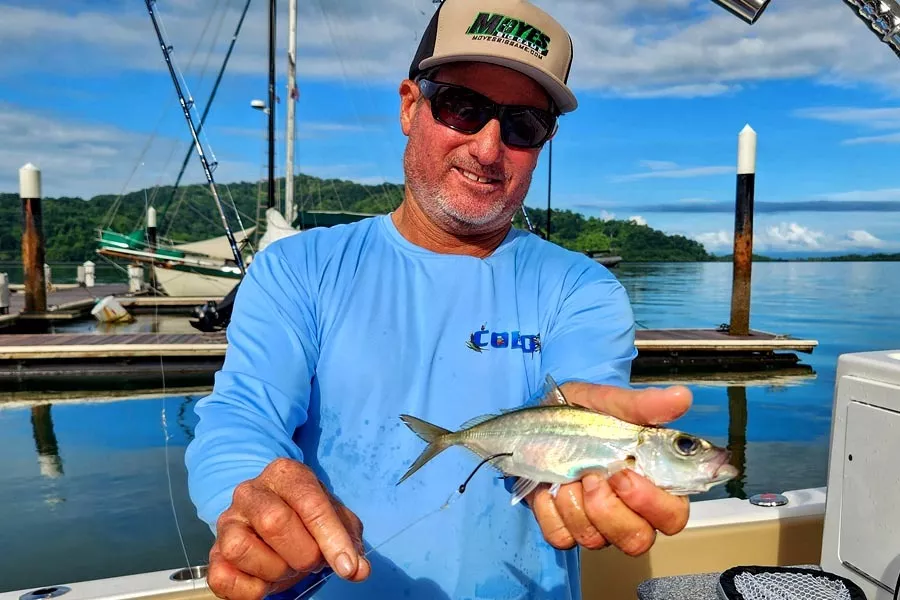
Artificial Lures
While not always as consistently effective as live bait, artificial lures can be highly productive and offer a more active fishing experience.

Topwater Lures
- Poppers:
- Size: 4-6 inches
- Why they work: Create commotion on the surface, mimicking struggling baitfish
- Best for: Calm to moderate surface conditions
- Stick Baits:
- Size: 6-9 inches
- Why they work: "Walk the dog" action mimics fleeing baitfish
- Best for: Covering water, aggressive fish
- Surface Walkers:
- Size: 5-7 inches
- Why they work: Erratic side-to-side action
- Best for: Enticing follows from wary fish
Subsurface Lures
- Swimbaits:
- Size: 6-10 inches
- Why they work: Realistic swimming action
- Best for: Imitating specific baitfish
- Jigs:
- Size: 7-12 ounces
- Why they work: Flash and vibration, ability to fish deep
- Best for: Vertical jigging over structure
- Diving Plugs:
- Size: 6-8 inches
- Why they work: Mimic injured baitfish, can be trolled or cast
- Best for: Covering water, fishing slightly deeper

Color Selection
Color choice can be important, especially with artificial lures. Here are some top color patterns for roosterfish:
- Silver/Chrome: Mimics the flash of baitfish
- Blue/White: Imitates common prey like sardines and mackerel
- Pink/White: High visibility, especially in slightly murky water
- Chartreuse: Stands out in darker or stained water
- Black: Creates a strong silhouette, especially on bright days
Local Insight: In very clear water conditions, such as those often found in Cabo San Lucas, more natural, subdued colors can be effective. In slightly murkier water, like that sometimes encountered in Costa Rica during the rainy season, brighter colors may produce better results.
Fly Fishing for Roosterfish
For those targeting roosterfish on the fly, here are some effective patterns:
- Poppers: Large, cupped-face poppers in white, pink, or chartreuse
- Streamers: Deceiver-style flies in blue/white or pink/white, 4-6 inches long
- Crease Flies: Large profile with good swimming action
- Needlefish Imitations: Long, slender profiles for calm conditions
Factors Influencing Bait and Lure Selection
- Water Clarity: In clear water, more natural presentations often work best. In murky water, opt for lures with more flash or vibration.
- Time of Day: Topwater lures are often most effective early and late in the day. Midday might call for deeper presentations.
- Prevailing Baitfish: Try to "match the hatch" by imitating the size and color of the predominant baitfish in the area.
- Fish Behavior: If roosterfish are aggressively feeding on the surface, topwater lures can be highly effective. For more reluctant fish, a live bait presentation might be necessary.
- Fishing Pressure: In heavily fished areas, roosterfish may become wary of commonly used lures. In these cases, trying something different or opting for the most natural presentation (live bait) can be key.
Remember, while having the right lures and baits is important, proper presentation is equally crucial. Practice your techniques and always be willing to adapt to the conditions and the fish's behavior on any given day.
Challenges of Catching Trophy Roosterfish
Targeting trophy roosterfish is an endeavor that tests an angler's skill, patience, and determination. While the reward of landing a massive rooster is unparalleled, the path to success is fraught with challenges. Understanding these obstacles can help anglers better prepare and increase their chances of success.
1. Elusive Nature
Roosterfish, especially large specimens, can be notoriously elusive:
- Unpredictable Behavior: Roosterfish often chase baits or lures only to turn away at the last moment.
- Seasonal Movements: Trophy fish may change their patterns seasonally, requiring anglers to constantly adapt.
- Selective Feeding: Large roosterfish can be surprisingly picky eaters, often ignoring baits that smaller fish readily take.
Strategy: Stay persistent and be prepared to change tactics if fish are showing but not committing.
2. Powerful Fighters
Once hooked, trophy roosterfish put up an incredibly strong fight:
- Explosive Runs: Roosterfish are known for making long, powerful runs that can quickly empty a reel.
- Endurance: Large specimens can fight for extended periods, sometimes over an hour.
- Unpredictable Fighting Style: They may change direction suddenly or dive deep, keeping anglers on their toes.
Strategy: Use appropriate gear rated for large game fish and be prepared for a lengthy battle.
3. Habitat Challenges
The preferred habitats of trophy roosterfish can present fishing difficulties:
- Rocky Areas: Fishing near rocks and reefs increases the risk of losing fish to structure.
- Surf Zones: Targeting roosterfish in the surf requires specialized techniques and can be physically demanding.
- Boat Positioning: In areas with strong currents or waves, maintaining the proper position can be challenging.
Strategy: Practice casting accuracy and learn to read the water to identify likely holding spots.
4. Weather and Environmental Factors
Environmental conditions can greatly impact roosterfish fishing:
- Wind: Strong winds can make casting difficult and affect boat positioning.
- Waves: High surf can make fishing from shore dangerous and boat fishing uncomfortable.
- Water Clarity: Roosterfish rely heavily on sight when feeding. Murky water can reduce their activity.
Strategy: Plan trips during optimal weather windows when possible, but be prepared to adapt to changing conditions.
5. Fishing Pressure
In popular fishing destinations, increased angling pressure can affect roosterfish behavior:
- Wariness: Fish in heavily fished areas may become more cautious and harder to fool.
- Changed Patterns: Constant pressure may alter traditional feeding and movement patterns.
- Reduced Numbers: Overfishing can lead to fewer trophy specimens in some areas.
Strategy: Consider fishing during off-peak times or exploring less pressured areas.
6. Technical Fishing Method
Some of the most effective methods for trophy roosterfish require advanced skills:
- Sight Fishing: Spotting and accurately casting to cruising fish demands practice and patience.
- Live Bait Fishing: Properly rigging and presenting large live baits takes experience.
- Fly Fishing: Catching roosterfish on the fly is extremely challenging, requiring specialized skills and equipment.
Strategy: Practice casting and techniques before your trip. Consider hiring a guide to learn advanced methods.
7. Physical Demands
Targeting trophy roosterfish can be physically taxing:
- Long Days: Success often requires putting in long hours on the water.
- Casting Large Lures: Repeatedly casting heavy lures or baits can be tiring.
- Fighting Fish: The prolonged fights typical with large roosterfish can be exhausting.
Strategy: Prepare physically before your trip and pace yourself on long fishing days.
8. Mental Game
The pursuit of trophy roosterfish requires mental fortitude:
- Patience: Long periods without action are common when targeting trophy fish.
- Disappointment: Lost fish and near-misses are part of the game.
- Decision Making: Constantly evaluating and adjusting tactics is necessary.
Strategy: Maintain a positive attitude and view each day on the water as a learning experience.
9. Gear Failures
The strength of trophy roosterfish can expose any weaknesses in tackle:
- Line Breaks: Frayed lines or poorly tied knots can lead to heartbreaking losses.
- Reel Failures: The stress of long runs can cause reels to seize or fail.
- Rod Breakage: High-sticking or manufacturing defects can result in broken rods during crucial moments.
Strategy: Use high-quality, well-maintained gear and check it regularly during fishing.
10. Ethical Considerations
Responsibly targeting trophy roosterfish involves ethical challenges:
- Catch and Release: Proper handling and release techniques are crucial for the fish's survival.
- Sustainable Practices: Balancing the desire for a trophy with conservation needs can be challenging.
- Photographic Evidence: Getting a photo while minimizing stress on the fish requires quick, careful handling.
Strategy: Educate yourself on best practices for catch and release and prioritize the fish's well-being over personal goals.
While these challenges may seem daunting, they are precisely what make landing a trophy roosterfish such a memorable achievement. By understanding and preparing for these obstacles, anglers can increase their chances of success and ensure a rewarding experience, regardless of the outcome.
Make Smart Choices With Your Roosterfishing
Roosterfish fishing, whether in the well-established waters of Cabo San Lucas or the more pristine environment of Costa Rica's Osa Peninsula, offers anglers an exhilarating and rewarding experience. These powerful, distinctive fish have rightfully earned their place among the most prized inshore game fish in the eastern Pacific.
Both destinations offer unique advantages:
- Cabo San Lucas provides reliable fishing opportunities with well-developed infrastructure, making it an excellent choice for anglers seeking comfort alongside their fishing adventure.
- The Osa Peninsula, with its less pressured waters and focus on eco-tourism, offers the chance for truly memorable encounters with trophy roosterfish in a spectacular natural setting.
Regardless of your chosen destination, success in roosterfish fishing comes down to understanding their behavior, employing the right techniques, and respecting the resource. The thrill of seeing a roosterfish's distinctive dorsal fin cutting through the water, the explosive strike, and the powerful fight that follows are experiences that create lasting memories for any angler.
Key takeaways from this guide include:
- Habitat Knowledge: Understanding the preferred habitats of roosterfish, from rocky points to sandy beaches, is crucial for success.
- Seasonal Considerations: Both Cabo San Lucas and the Osa Peninsula have peak seasons and off-seasons, each offering unique opportunities for roosterfish fishing.
- Technique Versatility: From live bait fishing to topwater lures and even fly fishing, being versatile in your approach can greatly increase your chances of success.
- Conservation Focus: The importance of practicing catch and release, especially for trophy-sized fish, cannot be overstated in maintaining healthy roosterfish populations.
- Preparation: Proper planning, from choosing the right gear to understanding local regulations, is key to a successful roosterfish fishing trip.
As you plan your roosterfish adventure, remember that the true value of the experience extends beyond just catching fish. The stunning coastal landscapes, the diversity of marine life, and the connection with nature all contribute to the allure of roosterfish fishing. Whether you're casting from the beaches of Cabo or exploring the wild coastlines of the Osa Peninsula, each day on the water offers new challenges and opportunities for growth as an angler.
Moreover, as stewards of the sport, it's our responsibility to ensure that future generations can enjoy the thrill of roosterfish fishing. By adhering to sustainable fishing practices, supporting conservation efforts, and spreading awareness about the importance of protecting these magnificent fish and their habitats, we can help preserve the roosterfish fishery for years to come.
In conclusion, whether you're a seasoned angler or new to the sport, pursuing roosterfish in either Cabo San Lucas or the Osa Peninsula promises an exciting and rewarding experience. The choice between these two world-class destinations ultimately comes down to personal preferences – the comfort and reliability of Cabo versus the wild, less-pressured waters of Costa Rica. Whichever you choose, the powerful runs, spectacular visual strikes, and the sheer beauty of the roosterfish guarantee an unforgettable fishing adventure.
So pack your gear, book your trip, and prepare for the fishing experience of a lifetime. The roosters are waiting, and the thrill of the chase is calling. Just remember, in the world of roosterfish fishing, every cast holds the potential for a trophy, and every release ensures that the thrill can be experienced again, by you and by future generations of anglers.
Tight lines, and may your next cast bring you face to face with the majestic roosterfish!
---
*Remember: Always check local regulations, hire reputable guides, and practice responsible fishing to help preserve the roosterfish population for future generations. Your actions today ensure great fishing experiences tomorrow.* Sarah Mendez Especialista de Pesca, In The Spread
User Reviews



